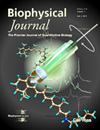疏水塌陷在细胞毒性和功能性淀粉样蛋白寡聚化中的作用。
IF 3.1
3区 生物学
Q2 BIOPHYSICS
引用次数: 0
摘要
淀粉样蛋白是一种不溶性的、高度组织化的蛋白质纤维,由分子间β-片组成,被称为交叉β基序。淀粉样蛋白通常被驱使聚集成紧密堆积的原纤维。一些淀粉样蛋白是功能性的,经常被用作激素储存库。功能的旁分泌信号神经肽β-内啡肽(βE)被储存和释放以调节疼痛反应。相反,与阿尔茨海默病有关的淀粉样蛋白-β (Aβ)的功能尚不确定,但有大量证据表明其在神经元细胞凋亡中的作用。虽然这两种肽在机械上都倾向于采用纤维状结构,但驱动细胞毒性潜能差异的生物物理特征尚未得到很好的理解。为了探讨功能性和细胞毒性低聚物形成的构象动力学和机制,我们利用全原子分子动力学(MD)模拟了单体和六聚体Aβ42和βE31的形成。单体a β42和βE31选择性取样由疏水残基组成的β链基序,采用塌缩状态。聚类分析表明,βE31六聚体的构象多样性高于Aβ42,表明βE31具有更多的无序特征。a - β42六聚体的形成是由崩塌的β链基序的疏水填料驱动的,其中βE31六聚体肽亚基在结构上保持可塑性和可溶性。a β42的突变破坏了c端疏水序列,抑制了疏水β链的形成,降低了聚集倾向,增加了溶剂可及性,表明保持崩溃状态对异常低聚物的形成至关重要。这项工作提供了细胞毒性和功能性低聚物形态在原子分辨率上的初步观点,获得了对淀粉样蛋白早期聚集事件的生物物理方面的见解。本文章由计算机程序翻译,如有差异,请以英文原文为准。
The role of hydrophobic collapse in cytotoxic and functional amyloid oligomerization.
Amyloid refers to an insoluble, highly organized protein fibril composed of intermolecular β-sheets, known as a cross-β motif. Amyloidogenic proteins are generally driven to aggregate into tightly packed fibrils. Some amyloids are functional, often being utilized as hormone storage reservoirs. The functional, paracrine signaling neuropeptide β-endorphin (βE) is stored and released to modulate pain responses. Conversely, the function of amyloid-β (Aβ), involved in Alzheimer's disease, is uncertain - but substantial evidence exists of its role in neuronal cell apoptosis. While both peptides are mechanistically linked in their propensity to adopt fibrillar structures, the biophysical characteristics that drive divergence in cytotoxic potential are not well understood. To probe the conformational dynamics and mechanisms of functional and cytotoxic oligomer formation, we utilized all-atom molecular dynamics (MD) to simulate the formation of monomeric and hexameric Aβ42 and βE31. Monomeric Aβ42 and βE31 selectively sampled β-strand motifs comprised of hydrophobic residues, adopting a collapsed state. Cluster analysis indicates that βE31 hexamers were more conformationally diverse than those sampled by Aβ42, suggesting βE31 exhibits more signatures of disorder. Aβ42 hexamer formation was driven by hydrophobic packing of collapsed β-strand motifs, where βE31 hexamer peptide subunits remained structurally plastic and solvent accessible. Mutation of Aβ42 disrupting the C-terminal hydrophobic sequence inhibited hydrophobic β-strand formation, reduced aggregation propensity and increased solvent accessibility, suggesting retention of a collapsed state is critical for aberrant oligomer formation. This work provides a preliminary view of cytotoxic and functional oligomer morphologies at atomistic resolution, gaining insights into the biophysical aspects of early aggregation events of amyloids.
求助全文
通过发布文献求助,成功后即可免费获取论文全文。
去求助
来源期刊

Biophysical journal
生物-生物物理
CiteScore
6.10
自引率
5.90%
发文量
3090
审稿时长
2 months
期刊介绍:
BJ publishes original articles, letters, and perspectives on important problems in modern biophysics. The papers should be written so as to be of interest to a broad community of biophysicists. BJ welcomes experimental studies that employ quantitative physical approaches for the study of biological systems, including or spanning scales from molecule to whole organism. Experimental studies of a purely descriptive or phenomenological nature, with no theoretical or mechanistic underpinning, are not appropriate for publication in BJ. Theoretical studies should offer new insights into the understanding ofexperimental results or suggest new experimentally testable hypotheses. Articles reporting significant methodological or technological advances, which have potential to open new areas of biophysical investigation, are also suitable for publication in BJ. Papers describing improvements in accuracy or speed of existing methods or extra detail within methods described previously are not suitable for BJ.
 求助内容:
求助内容: 应助结果提醒方式:
应助结果提醒方式:


